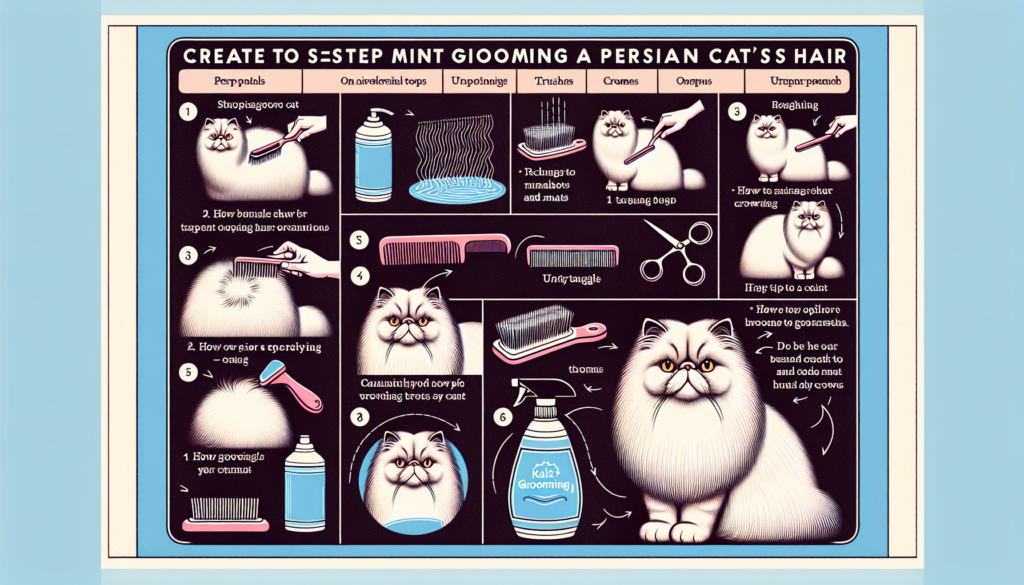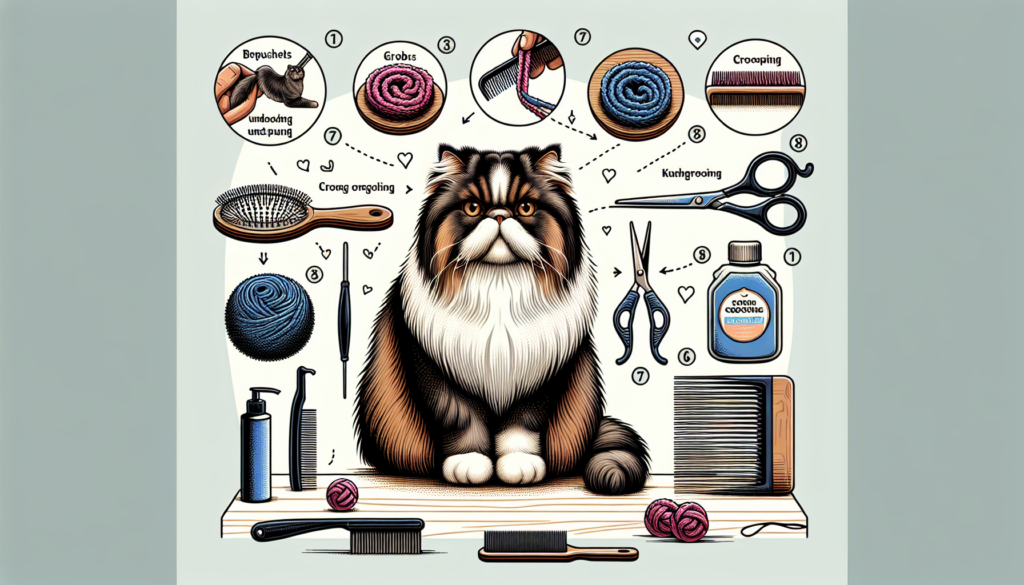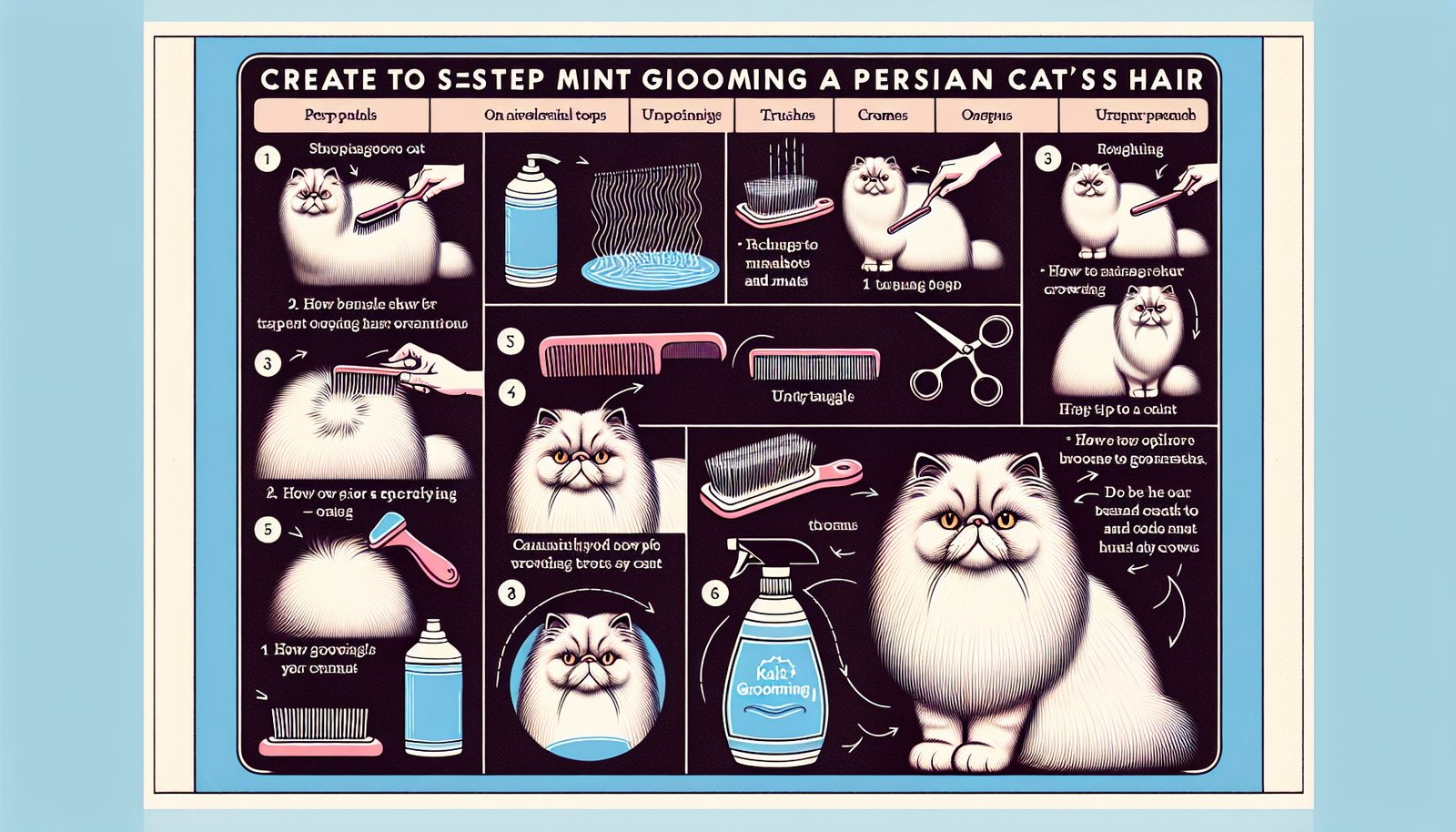If you’re a proud owner of a beautiful Persian cat, you know that their long and luxurious fur requires regular grooming to keep it looking its best. In this article, we will guide you on how to groom your Persian cat’s hair, ensuring that your feline friend stays clean, comfortable, and oh-so-stylish. From brushing techniques to tips on trimming their luscious locks, we’ve got you covered. So grab your brush and let’s give your Persian cat the pampering they deserve!
Preparing for Grooming
Grooming your Persian cat is an essential part of their care routine. Before you start grooming, make sure you gather all the necessary tools. This includes a brush suitable for your cat’s coat, a comb, cat-friendly shampoo, towels, and a blow dryer. Having all your tools ready will make the grooming process smoother and more efficient.
Creating a calm environment is also crucial for successful grooming sessions. Find a quiet space in your home where you and your cat can relax without distractions. Play some calming music and ensure the room temperature is comfortable. This will help your Persian cat feel at ease and make the grooming experience more enjoyable for both of you.
Brushing the Coat
Choosing the right brush for your Persian cat is key to maintaining their long and luxurious coat. Look for a brush with long, wide-spaced bristles to prevent pulling or damaging the fur. Regular brushing not only helps to keep the coat tangle-free but also promotes healthy circulation and removes loose hair.
When brushing your Persian cat, start from the head and work your way down to the tail. Be gentle and avoid pulling or tugging on the hair. Use long, sweeping motions to remove any loose hair and distribute natural oils throughout the coat. If you encounter mats or knots, use a comb or your fingers to carefully detangle them without causing discomfort to your cat.

Bathing Your Persian Cat
Bathing your Persian cat is a task that requires careful preparation and attention. Start by creating a designated bath area where you can comfortably wash your cat. Place a non-slip mat in the sink or bathtub to provide stability for your Persian cat during the bath.
Choosing the right shampoo is essential to ensure a gentle and effective cleanse. Opt for a cat-specific shampoo that is mild and pH-balanced. Avoid using human shampoos or products that may irritate your cat’s sensitive skin.
When lathering and rinsing the coat, be gentle and avoid getting water in your cat’s eyes or ears. Use your hands or a soft brush to work the shampoo into a lather, focusing on the areas that require extra attention, such as the belly and hindquarters. Rinse thoroughly to remove all traces of shampoo, as any residue can cause skin irritation.
Drying the Coat
After bathing, it’s time to dry your Persian cat’s coat. Start by gently towel drying your cat, being careful not to rub or tug on the hair. Persian cats have dense coats, so it may take some time to remove excess moisture.
Using a blow dryer on a low heat setting can help speed up the drying process. However, be cautious not to use a high heat setting, as it can damage your cat’s delicate skin. Keep the blow dryer at a safe distance from your cat and use your hands to provide a buffer between the dryer and the fur. Move the dryer in a gentle, sweeping motion to evenly dry the coat.

Trimming the Hair
Trimming your Persian cat’s hair is necessary to maintain their coat’s health and prevent matting. Before you start trimming, ensure your cat is calm and comfortable. Use treats or toys to incentivize good behavior and create a positive association with the grooming process.
When trimming, focus on areas prone to matting, such as the armpits, belly, and behind the ears. Use blunt-tipped scissors and trim small sections at a time to avoid accidental cuts. Be patient and take breaks if needed to ensure your cat remains relaxed throughout the process.
Cleaning the Eyes and Ears
Keeping your Persian cat’s eyes and ears clean is important for their overall health. Eye cleaning should be done regularly to prevent tear stains and discharge buildup. Use a damp cloth or cat-specific eye wipes to gently wipe away any debris from the corners of their eyes.
Ear cleaning should also be part of your grooming routine. Use a cat-specific ear cleaning solution and cotton balls or pads to clean the outer ear. Avoid inserting anything into your cat’s ear canal, as it can cause injury. Gently wipe away any dirt or wax visible on the outer folds of the ears.
Maintaining Healthy Skin
Regularly checking for skin issues is vital in maintaining your Persian cat’s overall health. Inspect their skin for dryness, redness, or any signs of irritation. If you notice any abnormalities, consult your veterinarian for proper diagnosis and treatment.
Using moisturizing products can help keep your cat’s skin hydrated and healthy. Look for cat-specific moisturizers or conditioning sprays that are formulated to nourish the skin and prevent dryness. Apply these products sparingly, focusing on areas prone to dryness or irritation.
Preventing Hairballs
Persian cats are prone to hairballs due to their long, dense coats. To prevent hairballs, ensure your cat is on a balanced diet that promotes healthy digestion. High-quality cat food formulated for hairball control can help minimize the hairball formation.
Regular grooming is another effective way to reduce shedding and minimize hairball risks. Brushing your Persian cat’s coat frequently helps to remove loose hair before it can be ingested during grooming. This not only keeps your cat’s coat healthy but also reduces the chances of hairballs.
Handling Shedding
Understanding shedding in Persian cats is essential for proper grooming. Persian cats have a longer shedding cycle compared to other breeds, and their thick fur can easily become matted if not properly maintained. Regular grooming sessions are crucial to manage shedding and prevent matting.
Use effective grooming methods to minimize shedding. Brush your cat’s coat daily with a wide-toothed comb or a slicker brush to remove loose hair. Pay attention to areas where shedding is more prominent, such as the flanks and hindquarters. Consistent grooming will help keep your Persian cat’s coat in top condition and minimize shedding around your home.
Seeking Professional Help
While grooming your Persian cat at home is rewarding, there may be situations where seeking professional help is necessary. If you are unsure about handling certain grooming tasks or encounter any difficulties, it’s best to consult a professional groomer.
Deciding when to consult a professional groomer depends on your comfort level and your cat’s grooming needs. If you’re unable to manage your cat’s coat, such as severe matting or behavioral issues during grooming, a professional groomer can provide expert assistance.
When choosing a groomer, ensure they have experience working with Persian cats. Check reviews and ask for recommendations from other cat owners to find a reputable groomer who understands the unique needs of Persian cats. Regular visits to a professional groomer can help maintain your cat’s coat and overall well-being.
Taking care of your Persian cat’s hair is an important responsibility as a pet owner. With the right tools, techniques, and a calm environment, grooming can be an enjoyable bonding experience for you and your furry friend. Regular grooming sessions not only keep your Persian cat looking their best but also contribute to their overall health and well-being. So grab your brush and start pampering your Persian cat’s glorious coat!

